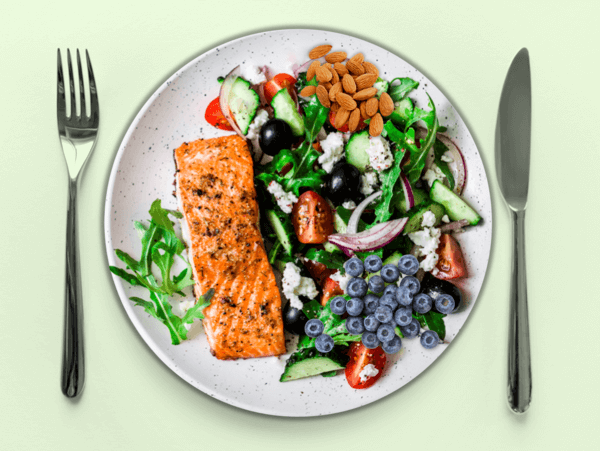What is Atrial Fibrillation?
Atrial fibrillation (AFib) is a heart condition that causes an irregular and often rapid heartbeat that can increase the risk of stroke. While some people with AFib have no symptoms, others experience a feeling of jumpiness in their chest or unusual fatigue. The most feared complication is stroke, caused by a blood clot that can form due to blood that is not efficiently ejected from the heart during atrial fibrillation.
Medication and procedures are the mainstays of therapy, but often overlooked is the key role that diet and lifestyle can play for prevention of atrial fibrillation.
How Common is Atrial Fibrillation?
More people are affected than ever, with a lifetime risk that exceeds 1 in 5 adults. By 2030, it’s estimated that 12 million Americans will be affected. This article will explore some diet and lifestyle changes that can help prevent it.
Atrial fibrillation is becoming increasingly prevalent because of the growing number of people living longer with chronic diseases that can trigger it, including prior heart attacks, high blood pressure, and various forms of kidney and lung disease.
Mediterranean Diet Lowers Risk of AFib

Recent studies have shown that individuals who follow a Mediterranean-style diet have a one-third lower risk of developing AFib than those who eat less healthfully. The Mediterranean diet emphasizes vegetables, fruit, nuts, and whole grains. These foods have an exceptionally high concentration of phytochemicals, protective compounds with potent antioxidant and anti-inflammatory properties.
Interestingly, extra-virgin olive oil, a prominent feature of the Mediterranean diet, has been closely linked to lower rates of AFib. And true extra-virgin olive oil (which is produced without chemicals or heat) is also known to have a high concentration of polyphenols.
Salt and Atrial Fibrillation
Another dietary factor that affects AFib risk is excessive salt. Loading up on dietary salt can increase the risk of atrial fibrillation, likely due to salt’s tendency to raise blood pressure. Some foods that contribute most to excess salt intake are not only the obvious salty choices, like chips and other salty snacks. Bread, cold cuts, pizza, tacos, and burritos are major contributors to salt overload. So, take care not to marinate your heart in salt—doing so can certainly raise your risk.
How Alcohol Affects the Risk of Atrial Fibrillation
Alcohol can be a potent trigger for atrial fibrillation, so much so that its occurrence around times of imbibing during celebrations is dubbed “holiday heart.” Alcohol can inflame the heart muscle and can further strain the heart by raising blood pressure. Those who consume more than two alcoholic drinks daily are up to 40 percent more likely to develop atrial fibrillation than those who don’t drink.
Caffeine and Atrial Fibrillation: A Surprising Relationship
Sensitivity to caffeine varies, and some people experience heart rhythm irregularities with even minimal caffeine intake. But for most individuals, studies have shown no association of typical coffee consumption with atrial fibrillation. Moreover, some studies show that drinking two to three cups of brewed coffee per day may actually help to protect the heart and reduce the risk of atrial fibrillation.
Weight and Atrial Fibrillation
The risk of atrial fibrillation increases in individuals with overweight and obesity. Studies show that as weight increases, the heart’s upper chambers tend to become larger, making the heart more vulnerable to atrial fibrillation. Additionally, excess fat tissue can surround the heart and begin forming within the heart muscle, making it more susceptible to irregular beats.
In contrast, weight loss reverses these changes and is associated with smaller-sized heart chambers and less fat interfering with the heart muscle. Individuals with obesity who lose 10 percent or more of their body weight have been shown to increase the likelihood of living without atrial fibrillation by 6x, compared to those with less weight loss.
Medical Conditions and Atrial Fibrillation
Sleep apnea is a stealthy condition that can lead to atrial fibrillation. Although often associated with individuals who have overweight or obesity, sleep apnea can occur across the weight spectrum and the diagnosis may be missed in those who don’t have the typical symptom of daytime drowsiness. A sleep study that involves medical monitoring during sleep is needed to make the diagnosis and is something to consider for people who have atrial fibrillation without a clear explanation. The good news is that treatment of sleep apnea may help to prevent further recurrences of atrial fibrillation.
Smokers double their risk of AFib compared to nonsmokers and quitting is another effective strategy for both prevention and treatment. Keeping high blood pressure under control and optimal management of blood sugar in those with diabetes are also integral steps to optimal Afib control.
Can Physical Activity and Yoga Help Atrial Fibrillation?
Being physically active is another effective tool to help manage AFib, including daily 30-minute walks. Of note, a regular yoga practice has been shown to reduce episodes of intermittent AFib by nearly 50 percent.
Diet and Lifestyle Add to the Benefits of an Ablation Procedure
For individuals who experience significant symptoms from atrial fibrillation or are at high risk for stroke, an ablation procedure may be recommended. An ablation procedure involves threading a very small wire through a vein in the arm or leg that is guided into the heart where it delivers a pulse of energy that neutralizes the short circuits responsible for atrial fibrillation.
While the initial success rate of an ablation procedure is over 70 percent, recurrences are common. An important and effective way to reduce the chances of AFib recurrence after an ablation is to add healthy lifestyle changes to the treatment plan. One large study of individuals followed after an ablation procedure showed that those who enrolled in a lifestyle modification program that involved weight loss, treatment of sleep apnea, and reduced alcohol intake had a nearly five-fold greater chance of living without Afib compared to those who did not make lifestyle changes.
Final Thoughts: The Value of an Integrative Approach
Atrial fibrillation is touching the lives of more people than ever before. Although new procedures and drugs have greatly aided management, long-term success is limited with high-tech alone. Fortunately, diet and lifestyle changes, added to conventional therapy, can increase the odds of living free of atrial fibrillation several-fold. The story of atrial fibrillation is yet another example of the beautiful marriage of high and low-tech needed to achieve optimal outcomes.
Nutrition Education for Medical Schools and Residency Programs
Prepare the next generation of health science professionals with practical, evidence-based nutrition science and patient-counseling skills.
Clinicians: Do you feel confident responding to patient questions about nutrition?
Take our award-winning condensed interactive nutrition CME—and learn what every clinician should know about nutrition.



